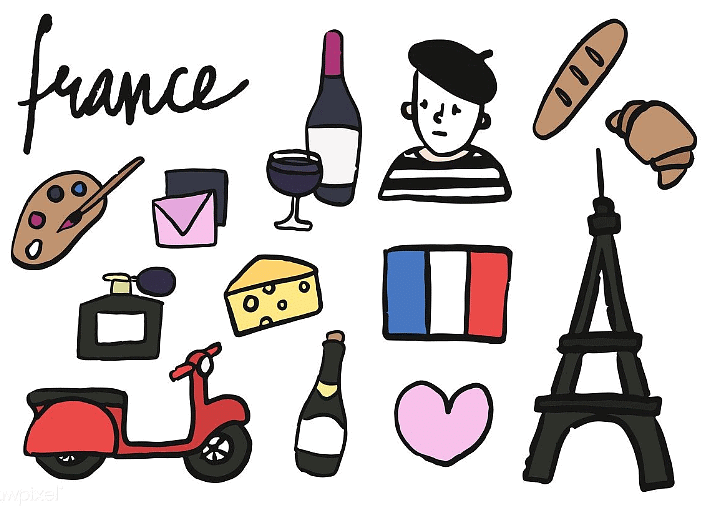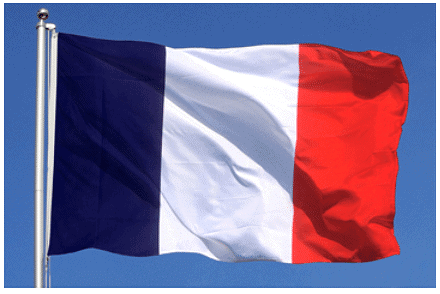Un coup d'œil sur la France Chapter Notes | French for Class 6 PDF Download
| Table of contents |

|
| Introduction |

|
| Le monde francophone |

|
| Apprenons les lettres et les sons |

|
| Apprenons les accents et la ponctuation: Les accents |

|
| A Guide to Pronunciation |

|
Introduction
France ou L'Hexagone
- Pronunciation: [lah frahns, soo-vah(n) tah-pay-lay 'leks-ag-ohn' ahn ray-zohn de sah form ah sees koh-tay, eh see-too-ay sewr luh kohn-tih-nah(n) ew-roh-pay-ehn. L vord-pay pahr ôoeet payee: lah bell-zheek, lahl-mah-nee, luh looks-om-boorg, lee-tah-lee, lah sweess, mon-ah-ko, lah(n)-dohr ay les-pahn-yuh.]

- English Translation: France or The Hexagon. France, often called 'The Hexagon' because of its six-sided shape, is located on the European continent. It is bordered by eight countries: Belgium, Germany, Luxembourg, Italy, Switzerland, Monaco, Andorra, and Spain.
Symboles nationaux de la France (National Symbols of France)

Le drapeau français: bleu, blanc, rouge.
- Pronunciation: [luh drahp-oh frahn-say: bluh, blahn, roozh.]
- English Translation: The French Flag: blue, white, red.
La capitale de la France: Paris.
- Pronunciation: [lah kah-pee-tahl deu lah frahns: pah-ree.]
- English Translation: The Capital of France: Paris.
La fête nationale: le 14 juillet.
- Pronunciation: [lah fet nah-syon-nahl: luh kah-tohrz zhwee-ay.]
- English Translation: The National Day: July 14th.
L'hymne national: la Marseillaise.
- Pronunciation: [leemn nah-syon-nahl: lah mar-say-yez.]
- English Translation: The National Anthem: La Marseillaise.
Aspects culturels et économiques (Cultural and Economic Highlights)
La monnaie unique européenne: l'euro.
- Pronunciation: [lah mwah-nay ew-neek ew-roh-pay-enn: luh-roh.]
- English Translation: The Common European Currency: The Euro.
Les vins: le bordeaux, le bourgogne, le beaujolais.
- Pronunciation: [lay vahn: luh bohr-doh, luh boor-gon-yuh, luh bo-zho-lay.]
- English Translation: Wines: Bordeaux, Burgundy, Beaujolais.
Les fromages: le camembert, le roquefort, le brie, le gruyère.
- Pronunciation: [lay froh-mahzh: luh kah-mahn-bair, luh rok-for, luh bree, luh groo-ye-air.]
- English Translation: Cheeses: Camembert, Roquefort, Brie, Gruyère.
Merveille d’ingénierie (Engineering Marvel)
- Le tunnel sous La Manche: le tunnel sous le bras de mer appelé La Manche, reliant l'Angleterre et la France.
- Pronunciation: [luh toon-nel soo lah mahnsh: luh toon-nel soo luh brah de mair ah-pay-lay lah mahnsh, ray-lee-ahn lah(n)-gleh-terr ay lah frahns.]
- English Translation: The Channel Tunnel: The tunnel under the body of water called the English Channel, linking England and France.
Le monde francophone
- Le français est la seule langue, à part l'anglais, parlée sur cinq continents. Plus de 150 millions de personnes parlent français comme langue maternelle et des millions d'autres l'utilisent comme langue secondaire. Ces personnes constituent ce qu'on appelle le monde francophone - le monde qui parle français. Certains des pays où le français est la langue officielle ou langue maternelle sont: l'Algérie, la Belgique, la Suisse, et le Luxembourg.
- Pronunciation: [luh mohnd frahn-koh-fon: luh frahn-say eh lah suul lahng, ah par lah(n)-gle, parl-ay sewr sank kohn-tih-nahn. Ploo duh san-kan-diz mee-yohn duh pair-son parl fran-say kohm lahng meuh-ternel e day mee-yohn dohtr luh-tee-leez kohm lahng seuh-kohn-dehr. Say pair-son kohn-stee-tew lay kee-on ah-pell luh mohnd frahn-koh-fon - luh mohnd kee parl frahn-say. Sair-ten day payee oo luh frahn-say eh lah lahng of-ee-see-ell oo lahng may-tuh-nel sohn: lal-zhay-ree, lah bell-zheek, lah sweess, ay luh looks-om-boor.]
- English Translation: The Francophone World. French is the only language other than English spoken on five continents. More than 150 million people speak French as their native tongue, and millions of others use it as a second language. These people make up what is known as the francophone world - the French-speaking world. Some of the countries where French is the official language or mother tongue are: Algeria, Belgium, Switzerland, and Luxembourg.
Apprenons les lettres et les sons
- Aa (aah)
- avion [ah-vee-ohn] - airplane
- abeille [ah-bay] - bee
Bb (beh)
- bonbon [bohn-bohn] - candy
- balai [bah-lay] - broom
Cc (ceh)
- chat [shah] - cat
- cadeau [kah-doh] - gift
Dd (deh)
- dame [dahm] - lady
- dodo [doh-doh] - sleep, or a colloquial term for sleepy
Ee (euh)
- étoile [ay-twahl] - star
- éléphant [ay-lay-fahn] - elephant
Ff (effe)
- fraise [frez] - strawberry
- fusée [foo-zay] - rocket
Gg (zhay)
- glace [glas] - ice cream
- girafe [zhee-raf] - giraffe
Hh (ahsh)
- hippo [ee-po] - hippo
- hibou [ee-boo] - owl
Ii (ee)
- île [eel] - island
- iguane [ee-gwan] - iguana
Jj (zhee)
- jambe [zhahmb] - leg
- jean [zhahn] - jeans
Kk (kah)
- kangourou [kahn-goo-roo] - kangaroo
- koala [koh-ah-lah] - koala
Ll (el)
- lion [lee-ohn] - lion
- langue [lahng] - tongue
Mm (em)
- maison [may-zohn] - house
- mère [mair] - mother
Nn (en)
- nid [nee] - nest
- nez [nay] - nose
Oo (oh)
- orange [oh-rahnzh] - orange
- oiseau [wah-zoh] - bird
Pp (peh)
- pantalon [pahn-tah-lohn] - trousers
- père [pair] - father
Qq (kyu)
- queue [kew] - tail
- quille [keel] - skittle or pin
Rr (air)
- raisin [ray-zan] - grape
- robe [rob] - dress
Ss (ess)
- soleil [soh-lay] - sun
- serpent [sair-pahn] - snake
Tt (teh)
- thé [tay] - tea
- tortue [tor-tew] - turtle
Uu (iu)
- une [ewn] - one (feminine)
- uniforme [ew-nee-form] - uniform
Vv (vay)
- vache [vahsh] - cow
- vase [vahz] - vase
Ww (doubluh vay)
- wagon [vah-gohn] - wagon
- week-end [week-end] - weekend
Xx (ix)
- xylophone [gzee-loh-fon] - xylophone
Yy (ye-grec)
- yeux [yeuh] - eyes
- yaourt [yah-oort] - yogurt
Zz (zed)
- zèbre [zeb-r] - zebra
- zéro [zay-ro] - zero
Apprenons les accents et la ponctuation: Les accents
É (é) - été [accent aigu]
- Pronunciation: [ay - etay]
- Found on the letter é.
È (è) - mère [accent grave]
- Pronunciation: [eh - mair]
- Found on the letters à, è, ù; the sound changes only with 'e'.
Ç (ç) - garçon [cédille]
- Pronunciation: [seh - garson]
- The cedilla comes under the 'c' – the sound changes from 'keh' to 'seh'.
Ë (ë) - Noël [tréma]
- Pronunciation: [uh - no-ell]
- The diaeresis indicates that the two vowels must be pronounced separately.
 (â) - hôtel [accent circonflexe]
- Pronunciation: [ah - otel]
- Can be found on any vowel a, e, i, o, u; no change in sound.
La ponctuation
- L'apostrophe (') - Indicates the omission of a vowel.
- Le trait d'union (-) - Used to connect words.
- Le point (.) - The full stop.
- Le point d'exclamation (!) - The exclamation point.
- Le point d'interrogation (?) - The question mark.
- Les guillemets (« ») - The quotation marks.
- L'arobase (@) - The at sign.
- La virgule (,) - The comma.
- Les sous-tiret (_) - The underline.
- La majuscule (A B C) - The capital letter.
- La minuscule (a b c) - The small letter.
A Guide to Pronunciation
The letter h
- Mostly silent in French.
- Examples:
- Homme [om]
- Hôtel [otel]
- Horloge [orloge]
The letter j
- Sounds like s in "measure."
- Examples:
- Je [jhe]
- Jardin [jhardan]
The letters t and d
- Have a softer pronunciation compared to their hard sounds in English.
- Examples:
- Tu [thu]
- Tomate [thomat]
- Table [thable]
- Disque [disk]
The letter c
- Sounds like s when followed by i or e, but like k otherwise.
- Examples:
- Ce [se]
- Cette [set]
- Cidre [sidre]
In French, ch always has the sound of sh
- Not as ch in "chair."
- Examples:
- Chaise [shaise]
- Château [shato]
Some letters in a word are not pronounced in French
- The last consonant in a word is typically silent.
- Examples:
- Chat [sha]
- Petit [peti]
The last e in a word is not pronounced
- Examples:
- Theatre [théatreh]
- Difficile [difficeel]
- Aime [aim]
- Examples:

|
17 videos|44 docs
|
FAQs on Un coup d'œil sur la France Chapter Notes - French for Class 6
| 1. Quels sont les différents accents utilisés dans la langue française ? |  |
| 2. Pourquoi est-il important de connaître les accents en français ? |  |
| 3. Comment peut-on apprendre à reconnaître et utiliser les accents en français ? |  |
| 4. Quelle est la différence entre l'accent aigu et l'accent grave en français ? |  |
| 5. Comment peut-on taper les accents sur un clavier d'ordinateur ? |  |





















